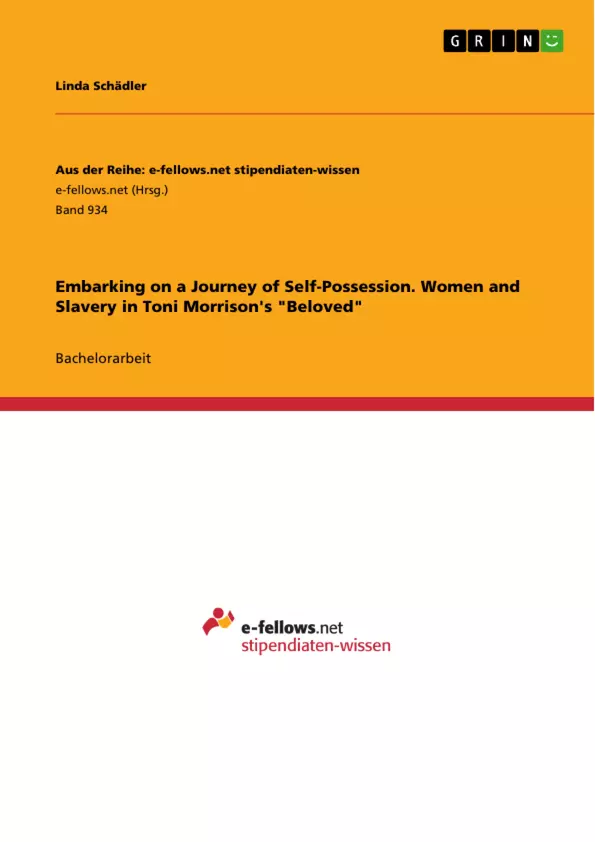Slavery is terrible for men; but it is far more terrible for women. Superadded to the burden common to all, they have wrongs, and sufferings, and mortifications peculiarly their own (Jacobs 85).
Harriet Ann Jacobs, author of the above quote, was an African-American slave and abolitionist, who published her slave narrative Incidents in the Life of a Slave Girl in 1861 – 16 years after Frederick Douglass’ highly successful, but male-centered autobiographical narrative – thereby providing one of the first accounts of female slaves’ struggle for freedom and self-determination and the physical and sexual abuse they had to endure during slavery. While slavery was an extremely painful and dehumanizing experience for all slaves, it was, as depicted by Jacobs, in many ways even more difficult for females. Their sexual vulnerability rendered them easy prey to the exploitation and abuse of power both by their white masters and fellow male slaves. However, until the 1980s, this relevant aspect of African-American history had been largely neglected by historians and writers alike, even those of African-American heritage themselves.
Yet, with the emergence of authors like Toni Morrison, Alice Walker, and Maya Angelou, a new awareness has been created for the unique fate of black women in the pre- and post-Civil War period, and the impact that slavery had on their identity formation as well as their role in the African-American slave community. Toni Morrison, the first African-American to be awarded the Nobel Prize for Literature, was in fact among the first writers to draw attention to the double marginalization of African-American women. Morrison’s novel Beloved for instance, published in 1987, is based on the true story of Margaret Garner, a runaway slave who killed one of her own children to spare her a life in slavery. Beloved itself primarily explores the traumatic circumstances that led to the event, as well as the protagonists’ painful process of psychological recovery. This highly personal account of female slave experience allows us to examine the influence slavery had on African-American women and their families, and its impact on their relations to the black community.
Inhaltsverzeichnis
- Introduction
- Historical Background
- The Middle Passage and the Following Work Exploitation in the New World
- Sexual Exploitation: Breeding and Rape
- Dehumanization and Degradation through Sexual Abuse
- Beloved's Ambiguous Fate, and Ella and 'the Lowest Yet'
- Sethe's Humiliation through Schoolteacher
- Mothers and Daughters
- Sethe's Dysfunctional Relationship to Her Mother
- Sethe's Overly 'Thick' Love for Her Children
- Women and the Community
- Baby Suggs's Disrupted Family and Her Importance for the Community
- Sethe's Role as Head of the Nuclear Family
- Love and Sexuality
- Slavery's Notions of Love and Sexuality and the Male and Female Trauma
- Paul D's Significance for Sethe's Recovery Process
- Conclusion
- Bibliography
Zielsetzung und Themenschwerpunkte
Die Bachelorarbeit analysiert Toni Morrisons Roman "Beloved" und untersucht die Auswirkungen der Sklaverei auf die Selbstfindung und Emanzipation schwarzer Frauen im Kontext der amerikanischen Geschichte. Die Arbeit beleuchtet die historischen Hintergründe und die besonderen Herausforderungen, denen schwarze Frauen im 19. Jahrhundert in den Vereinigten Staaten gegenüberstanden, insbesondere durch sexuelle Ausbeutung, Dehumanisierung und die Zerstörung von Familienstrukturen.
- Sexuelle Ausbeutung und Dehumanisierung schwarzer Frauen während der Sklaverei
- Die Rolle von Müttern und Töchtern in einer von Sklaverei geprägten Gesellschaft
- Die Bedeutung von Gemeinschaft und Solidarität für die Selbstfindung und Heilung
- Die Herausforderungen bei der Entwicklung von Liebe und Sexualität im Kontext der Sklaverei
- Die Bedeutung von Toni Morrisons Werk für das Verständnis der Geschichte und der heutigen Situation schwarzer Frauen
Zusammenfassung der Kapitel
Die Arbeit beginnt mit einer Einführung in das Thema und stellt die Relevanz von Toni Morrisons "Beloved" für die Erforschung der Geschichte und der Erfahrungen schwarzer Frauen in den Vereinigten Staaten heraus. Das zweite Kapitel beleuchtet die historischen Hintergründe der Sklaverei, einschließlich der grausamen Bedingungen der "Middle Passage" und der sexuellen Ausbeutung schwarzer Frauen, die als "Zuchttiere" und Objekte der Begierde betrachtet wurden. Das dritte Kapitel analysiert die Dehumanisierung und Degradation durch sexuelle Gewalt anhand der Charaktere Beloved, Ella und Sethe. Es zeigt, wie die sexuelle Ausbeutung die Psyche schwarzer Frauen prägte und ihre Beziehungen zur Gemeinschaft beeinflusste.
Das vierte Kapitel widmet sich dem Einfluss der Sklaverei auf die Mutter-Tochter-Beziehung, insbesondere anhand der Beziehung zwischen Sethe und ihrer Tochter Denver. Die Arbeit untersucht, wie Sethe's dysfunktionale Beziehung zu ihrer eigenen Mutter ihre eigene Rolle als Mutter prägte und die Entwicklung ihrer Kinder beeinflusste. Das fünfte Kapitel beleuchtet die Bedeutung von Gemeinschaft und Solidarität für die Überwindung von Trauma und die Selbstfindung, insbesondere anhand der Rolle von Baby Suggs und der Cincinnati-Gemeinschaft. Es zeigt, wie die Gemeinschaft trotz ihrer eigenen Unsicherheiten und Ängste eine wichtige Rolle bei der Heilung von Sethe und Denver spielt.
Das sechste Kapitel befasst sich mit den Herausforderungen bei der Entwicklung von Liebe und Sexualität im Kontext der Sklaverei. Die Arbeit analysiert die Beziehung zwischen Sethe und Paul D sowie die Bedeutung von Paul D für Sethe's Heilungsprozess. Es zeigt, wie die Erfahrungen der Sklaverei die Wahrnehmung von Liebe und Sexualität verzerrten und die Entwicklung von intimen Beziehungen erschwerten. Die Arbeit schließt mit einem Ausblick auf die Bedeutung von Toni Morrisons Werk für das Verständnis der Geschichte und der heutigen Situation schwarzer Frauen. Es zeigt, wie Morrisons Roman "Beloved" wichtige Fragen aufwirft und das Bewusstsein für die anhaltende Diskriminierung und Marginalisierung schwarzer Frauen in den Vereinigten Staaten schärft.
Schlüsselwörter
Die Schlüsselwörter und Schwerpunktthemen des Textes umfassen die Sklaverei in den Vereinigten Staaten, die Geschichte schwarzer Frauen, sexuelle Ausbeutung, Dehumanisierung, Mutter-Tochter-Beziehungen, Gemeinschaft und Solidarität, Liebe und Sexualität, Trauma und Heilung, Toni Morrisons "Beloved", Selbstfindung und Emanzipation.
- Quote paper
- Linda Schädler (Author), 2012, Embarking on a Journey of Self-Possession. Women and Slavery in Toni Morrison's "Beloved", Munich, GRIN Verlag, https://www.grin.com/document/274936



